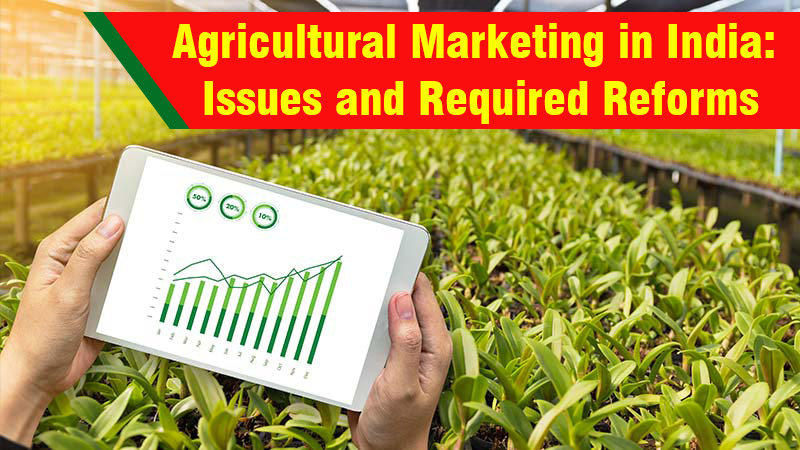India went for Green Revolution in the agricultural sector in the 1960s to try to attain self-sufficiency in food production.
Since then, every government in India has highlighted raising agriculture production to make India self-reliant in feeding its increasing population.
However, agricultural marketing hasn’t received the corresponding attention as compared to agricultural production.
But Nowadays agricultural marketing becomes an important factor in concern with the Indian economy.
Problems in Indian Agricultural Marketing
Issues Related to Minimum Support Price
MSP announced for 23 crops but given for only a few crops, this is the major issue in agricultural marketing. MSP is given with unsatisfactory norms according to farmers, so this is not that trustworthy in farmers.
Government procurement facilities with MSP not available throughout the country. The government provides MSP for only cereals but most of the agricultural income comes from dairy products, vegetables, and horticulture.
These are major issues related to MSP, so this system of MSP can’t that much contribute to agricultural marketing.
Issues Related to Agricultural Produce Market Committee (APMC)
In Terms of paper or technical, APMC has so many buyers but in practice, few are in existence. Because in most APMCs, buyers purchase through licensed aadhatiyas (middlemen).
These middlemen charge a commission from both the buyer and seller for their services. Most of the time they work as moneylenders, supplying seeds, fertilizers, and pesticides to farmers on credit and forced farmers to sell their agricultural produce to them at low prices.
After that, so many taxes and mandi fees are there create another issue.
Distress Sale Due to Lack of Storage Infrastructure in India
Due to the lack of storage facilities in India, so many farmers sell their agricultural produce just after harvesting, without thinking of price and profit.
Farmer required money for next crop production, and they can’t afford high charges in private sector storage facilities available in India.
Reforms Required in Indian Agriculture Marketing
Fixed Mandi Fees Throughout the Country
It is recommended that a uniform mandi charge of 0.25% or 0.50% be required cross country for food grains, oilseeds, and natural products and vegetables.
The resulting misfortunes to APMCs might be repaid by the Center and state governments, as on account of the GST.
Low Aadhatiya-based Trading
All exchange APMCs ought to be through open selling, including various bidders for each part. Such exchanges ought to be straightforwardly among purchasers and merchants, with no go-between charging commission. The aadhatiya can partake just as a trader.
Sample Based Deals
The Farmers today carries his entire production to the APMC, and the purchasers do the actual assessment prior to offering. These outcomes in twofold transportation from the farmland to APMC and from the APMC to a definitive objective.
If reviewing and arranging offices exist nearer to the farmland, the farmer needs to take just a sample of his produce, alongside the significant quality affirmation reports, to the mandi. It would save both time and cost.
Storage and Backing Facilities
Due to Nearer storage facility transport cost will be saved and due to nearer banking facilities, it becomes easy for safe financial exchange.
Promotion of Advance FPO –
FPO ought to be urged to take up direct advertising of their individuals’ produce to huge purchasers and processors. It will bring about more rivalry and better costs at APMCs.
Essential Commodities Act (ECA)
ECA places limitations on the development of produce, stockholding, estimating, and selection of new advancements.
The destroying of such controls under ECA and different guidelines would grow exchange and lead to better acknowledgment for farmers.
e-NAM
The public authority has made an electronic national agriculture market (eNAM) to interface all controlled wholesale produce markets through a pan India Trading Portal.
Its viability is, notwithstanding, subject to the interest of merchants from these mandis.
Risk Management in Agriculture marketing
Crop Insurance plans offer assurance to farmers against climate change. The premium in the Pradhan Mantri Fasal Bima Yojana is generally borne by the Government.
Increment in the Number of Markets
As indicated by Ashok Dalwai Committee, India needs 30,000 agriculture markets. There is a requirement for a small market idea to connect this wide sector.
The government’s declaration of GRAMs (Gramin Rural Agriculture market) is a positive development. Likewise, with pervasive electronic correspondence and dependable provincial streets, GRAMs can become practical center points for financial movement and work age.
AgriTech new companies ought to be roped in for the value disclosure component, so that value unpredictability can be controlled.
Farmer Consolidation
Union of little and divided farmers into the more practical property will improve makers’ admittance to fund and quality data sources, other than empowering better value acknowledge.
This will likewise boost truly necessary interests in land advancement/improvement and farm mechanization.
Without modification in the agriculture marketing sector doubling the farmer, income is not possible.
Download KhetiGuru Mobile Application for more details about the agriculture sector.
Visit our page for more information about Tractor, Agricultural implements, Tractor Price, Tractor Videos, and Tractor Games.




